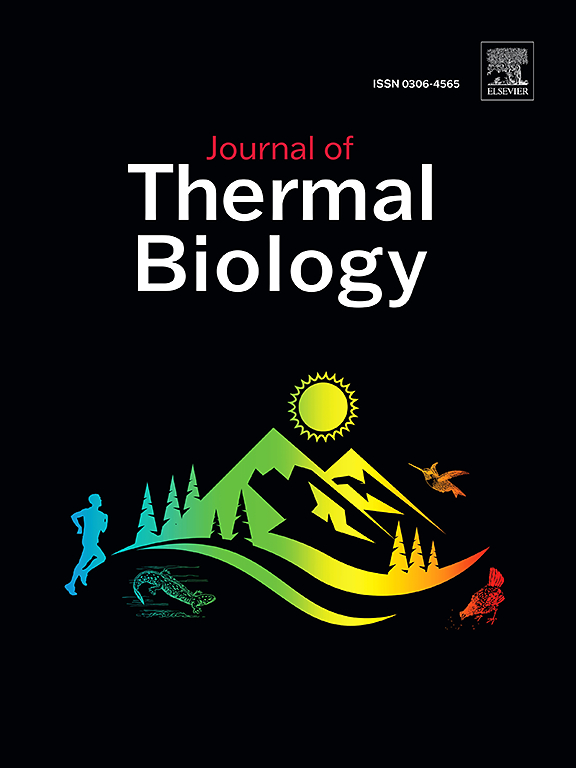胚胎孵化温度调节白鲟幼体的行为
IF 2.9
2区 生物学
Q2 BIOLOGY
引用次数: 0
摘要
白鲟生活在北美太平洋沿岸的大河和河口,具有重要的生态和文化作用。与其他变温动物一样,全球气温的预期上升将给鲟鱼带来生理上的挑战,包括对生理速率的直接影响,还可能导致影响生存的行为变化。在这项研究中,我们通过在三种胚胎温度(12°C、15°C或18°C)中的一种下孵育白鲟(transmontanus)从受精到孵化,然后在15°C下孵育30天,研究了白鲟(Acipenser transmontanus)的“携带效应”。我们研究了这些孵育温度在18、24和30 dph下对后续行为的影响,包括运动和焦虑样行为。开放场地测试用于量化鱼移动的距离和在竞技场外墙附近停留的时间(量化thigmotaxis,一种焦虑样行为的指标),并用运动跟踪软件记录。该测试还用于比较白天和夜间(21英里/小时)和夜间每小时(28英里/小时)的行为。此外,还首次在24 dph下对鲟鱼幼虫进行了啮齿类动物和其他鱼类常用的光/暗试验。我们发现了显著的家族效应;胚胎饲养温度对鱼的运动和移动性的影响因鱼的家族谱系而异。此外,我们提供的证据表明,鲟鱼幼虫在24和30英里/小时时比18英里/小时表现出更大的运动能力,并且对光/暗测试的亮区有偏好。我们的研究结果确定了孵育温度对生命后期阶段的更细微的影响,这种影响随家庭血统而变化,并强调了在研究和保护计划中考虑这种变化的必要性。本文章由计算机程序翻译,如有差异,请以英文原文为准。
Embryological incubation temperature modulates behaviour in larval white sturgeon (Acispencer transmontanus)
White sturgeon inhabit large rivers and estuaries along the Pacific coast of North America and play important ecological and cultural roles. As with other poikilotherms, the expected rise in global temperatures will create physiological challenges for sturgeon, including direct effects on physiological rates, and may also cause changes in behaviour that impact survival. In this study, we investigated ‘carryover effects’ in white sturgeon (Acipenser transmontanus) by incubating fish at one of three embryological temperatures (12 °C, 15 °C, or 18 °C) from fertilization to hatch, and then holding them at 15 °C for the following 30 days post-hatch (dph). We investigated the effect of these incubation temperatures on subsequent behaviours, including locomotion and anxiety-like behaviour, at 18, 24 and 30 dph. The open field test was used to quantify distance moved by the fish and time spent near the outer wall of the arena (to quantify thigmotaxis, an indicator of anxiety-like behaviour) and recorded with motion-tracking software. This test was also used to compare behaviour during the day versus night (at 21 dph) and hourly at night (at 28 dph). Additionally, a light/dark test commonly used in rodents and other fish species was performed for the first time on larval sturgeon at 24 dph. We found a significant family effect; the impact of embryo rearing temperature on locomotion and thigmotaxis varied depending on the family lineage of the fish. Furthermore, we provide evidence that larval sturgeon exhibit greater locomotion at 24 and 30 dph compared to 18 dph, and have a preference for the light zone of the light/dark test. Our findings identify a more nuanced effect of incubation temperature on later life stages that varies with family lineage and underscores the need to consider such variation in research and conservation programs.
求助全文
通过发布文献求助,成功后即可免费获取论文全文。
去求助
来源期刊

Journal of thermal biology
生物-动物学
CiteScore
5.30
自引率
7.40%
发文量
196
审稿时长
14.5 weeks
期刊介绍:
The Journal of Thermal Biology publishes articles that advance our knowledge on the ways and mechanisms through which temperature affects man and animals. This includes studies of their responses to these effects and on the ecological consequences. Directly relevant to this theme are:
• The mechanisms of thermal limitation, heat and cold injury, and the resistance of organisms to extremes of temperature
• The mechanisms involved in acclimation, acclimatization and evolutionary adaptation to temperature
• Mechanisms underlying the patterns of hibernation, torpor, dormancy, aestivation and diapause
• Effects of temperature on reproduction and development, growth, ageing and life-span
• Studies on modelling heat transfer between organisms and their environment
• The contributions of temperature to effects of climate change on animal species and man
• Studies of conservation biology and physiology related to temperature
• Behavioural and physiological regulation of body temperature including its pathophysiology and fever
• Medical applications of hypo- and hyperthermia
Article types:
• Original articles
• Review articles
 求助内容:
求助内容: 应助结果提醒方式:
应助结果提醒方式:


